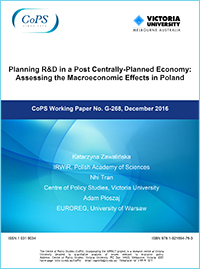
Planning R&D in a Post Centrally-Planned Economy: Assessing the Macroeconomic Effects in Poland
Half a century of centrally planned policy in the Central and Eastern European countries resulted in outdated technologies, inefficient allocation of resources and low productivity. Following the end of communism there was a fifteen year process of transition which ended in 2004 with eight post-communist countries joining the European Union (EU) of which Poland was the largest. As part of the EU these countries now face the challenge of the common EU strategy Europe 2020, which has set the target of achieving R&D expenditure to GDP ratio (called the R&D intensity) of 3% by 2020 for the Union as a whole in an effort to increase the competitiveness of the region. Poland, like the other post-communist countries, faces a lower target of R&D intensity, set at 1.7%. Nevertheless, the challenge is immense, since the country is still at only half that level and has little experience in developing policies to help achieve it. In this paper we tested two possible policy options to achieve the target: (1) to increase government expenditures on R&D and; (2) to provide tax relief on R&D to businesses. The method applied to assess the options is a multi-regional recursive dynamic computable general equilibrium (CGE) model for Poland with an explicit link between productivity and R&D stock. The results show that achieving the R&D intensity target via the use of tax relief is 2.5 times more costly to the government budget, but it has a greater impact on the economy in terms of a higher GDP growth. Tax relief proved efficient in the short run while in the long run the government expenditure policy provides better value for money.




